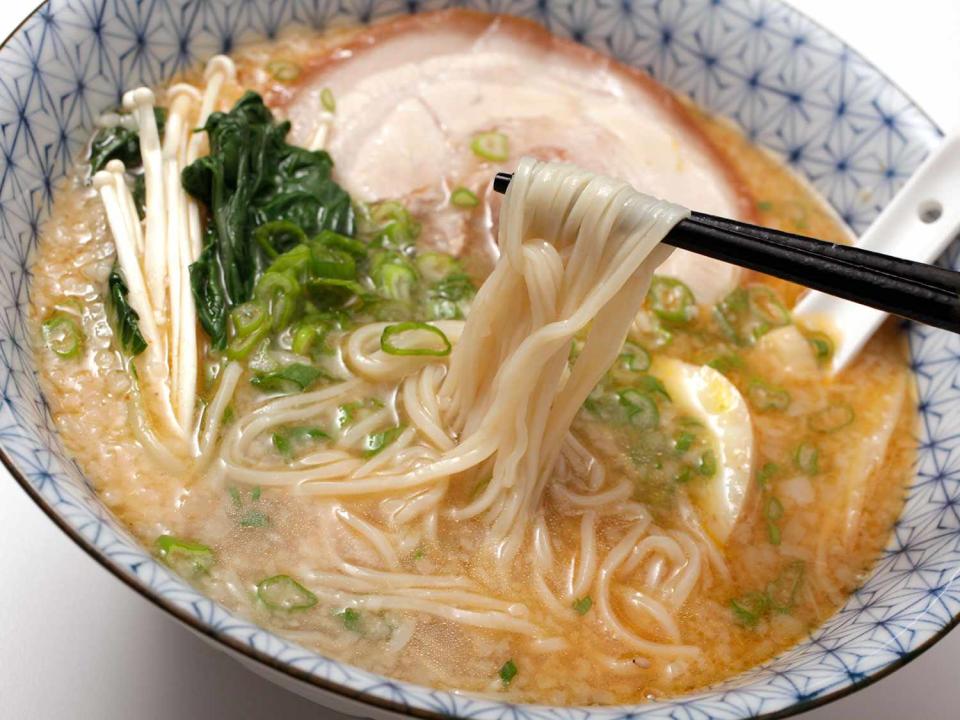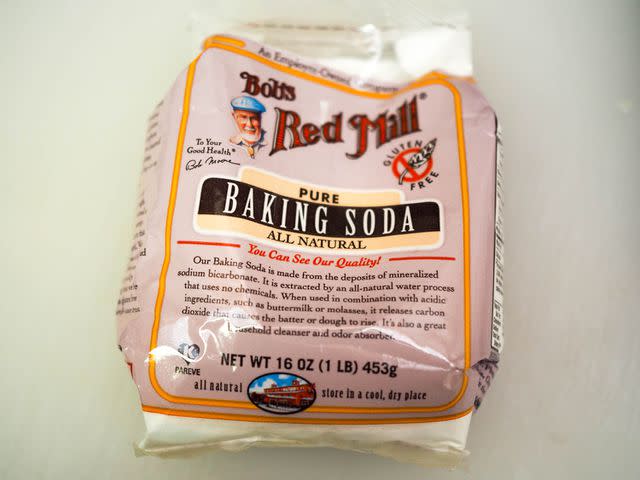Turn Your Pasta Into Ramen With Baking Soda
Word on the street is that you can turn any noodle into a ramen noodle by boiling it in baking-soda water. We've put the claim to the test.

Pop quiz: You're dying for some ramen but aren't anywhere near a place that serves it—and no, the 99-cent instant stuff isn't going to cut it. You live in a neighborhood overflowing with all the ingredients you'd need for, say, Mexican food, but Japanese? Not a chance. What do you do?
If you'd asked me this two days ago, I would have said that you should eat something else. Today, I'd say, What's the problem? You've got everything you need at your fingertips...perhaps it's already in your pantry.
If you haven't already guessed, I was the one who wanted to make ramen a couple days ago, but was having a hard time getting my hands on an acceptable noodle. I was messaging with Kenji about my options, which were starting to look kind of bleak.
And then he messaged me:
kenji Oh, my mom was reading a Japanese blog earlier this week that mentioned cooking spaghetti in water with baking soda and it ends up with a ramen-like texture. Have you ever tried that?
dgritzer Wow, no never
dgritzer Makes some kind of sense
kenji Yeah
Then he sent me a link to the Japanese blog. I can't make any sense of the text, but the pictures speak for themselves.
Does This Really Work?
For those of you reading this and wondering why baking soda might make "some kind of sense," the answer is that the ingredient that gives ramen noodles their characteristic yellow color and springy bite is kansui (alkaline minerals). Because kansui can be hard to find outside of Asia, some cooks will use baking soda (or even baked baking soda) instead, since baking soda is also alkaline. (You can read more about the elements of ramen, including the noodles, in Kenji's guide here.)
But the kansui or baking soda is usually worked into the ramen noodle dough itself. The suggestion here was that you could just add baking soda to the cooking water and turn any old strand of spaghetti into something that seemed ramen-like.
Ladies and gentlemen, this is a very exciting idea.
The only question was: Does it work?

I had no idea what ratio of baking soda to water to use, so I did a little sniffing around the web and found a couple blogs that gave a ratio of 1 tablespoon baking soda per quart (or liter) of water.

Armed with that information, I dropped 2 tablespoons of baking soda into 2 quarts of water, seasoned it with salt, and brought it to a boil.
The water can fizz a lot when the baking soda goes in, so make sure your pot isn't too full.

Then I added angel hair pasta. It's not a noodle I ordinarily use, but I wanted thin ones in the homemade ramen I was going to add them to... assuming this trick worked.

The baking soda water, once filled with the pasta starch, will start to froth. Keep an eye on it and stir often to avoid bubbling over.

The noodles that came out seemed to be more yellow. I took a bite: Definitely more springy! But then a bitter, soapy aftertaste settled into my mouth.
I started playing with other ratios, like 2 teaspoons per quart and 1/2 tablespoon per quart. The effect was still there, but not quite as drastic. When I plunged my original noodles—the ones made with a full tablespoon of baking soda per quart of water, into my flavorful ramen broth—the amazing thing was that I hardly noticed the bitter aftertaste at all.
Tips, Tricks, and the Right Proportion
My conclusion is that if you have a delicate broth, it's better to err on the side of less baking soda, using 2 teaspoons per quart of water. But when you have a full-flavored broth, go ahead and use 1 full tablespoon of baking soda per quart of water. You'll get slightly better results, and won't be able to taste the baking soda once the noodles are in the soup.
There are a couple things to be very careful about when using this method. This first is to not let your water steam away while you're distracted with other cooking tasks: as the water reduces, the baking soda will concentrate, and you will end up with terrible results. I know, because I made that mistake. My pasta came out tasting like ammonia. It was far less palatable than the Icelandic fermented shark I'd eaten earlier in the day.
The second is that, at least judging by my tests, it's difficult to use the water for more than one or two batches of pasta, even if you top it up with more water to account for evaporation: The water itself turns yellower and yellower with each successive batch, presumably from pasta starch that's leached into it and continues to darken as it cooks. New batches of pasta cooked in that water turn an unpleasant brown color, and I also detected a stronger baking-soda flavor, though it's possible my perception was influenced by the appearance of those brown noodles.
To show the difference between regular pasta, and the baking-soda-water pasta, I did two side-by-side batches of angel hair. The one on the left is the baking-soda one, and you can clearly see the color difference.

I've also tested this out with spaghetti and linguine, and the results are the same: yellower noodles with a springier bite and just a hint of that mineral flavor. But I liked the effect most with the angle-hair pasta, since it's the one you least expect to remain resilient once cooked. The linguine was my least favorite— there's something about its extra broad shape that makes it less pleasant to eat like this.
These MacGyvered noodles won't fool a ramen aficionado, but they're good enough that I'll no longer let a lack of Asian noodles in my neighborhood prevent me from making ramen for dinner.
I'm going to go ahead and call this a home-cooked ramen game-changer.

